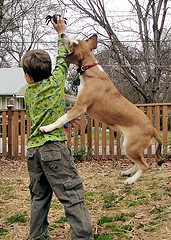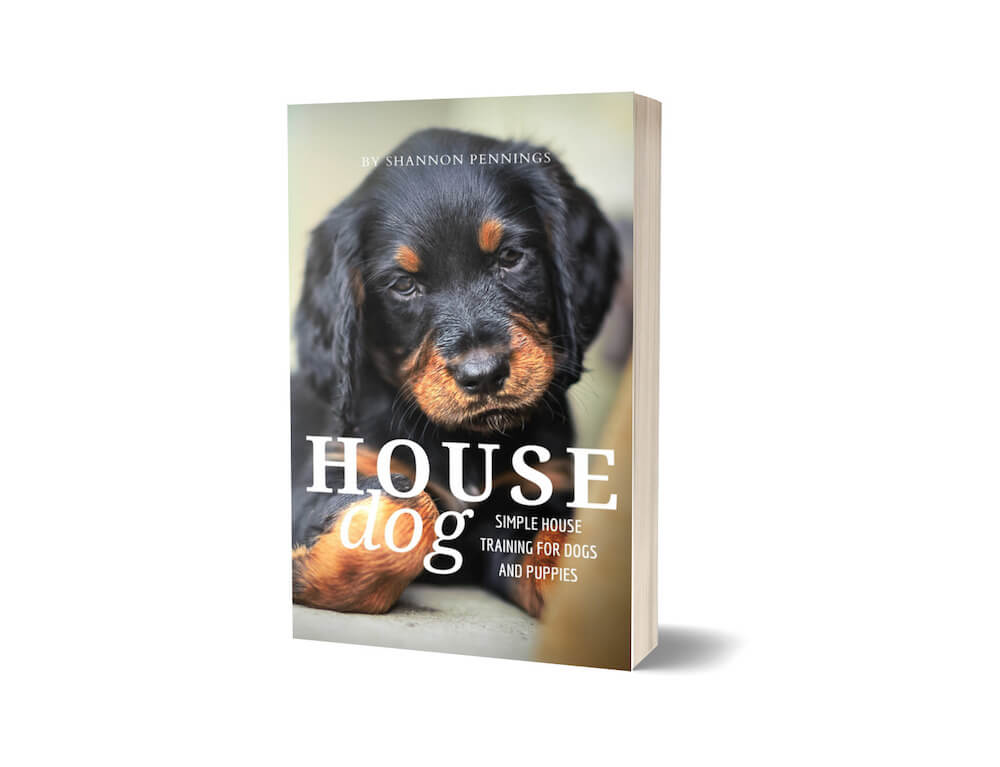Sure-fire Solution for Dog Jumping (continued)
Jumping dogs are not cute. Nor are they funny. Unless you've given your
dog a command to jump (i.e. in dog sports), a dog should never, ever,
ever have his paws on any part of your body!
You've likely tried some tips you found online to stop your jumping dog.
Turn your back to the dog when he jumps on you (ignoring him). Don't
make eye contact. Wait for him to settle down before praising him.
Well, if you're reading this article, chances are that these techniques
didn't work.
If you haven't already read the first page on dog jumping, where I talk
about why dogs jump, how you've been inadvertently praising him to jump,
and a couple steps to get started on first, take a few minutes to pop
over there for a quick read before continuing on here. It's sort of a
prerequisite to the steps laid out here.
Back again? Alright, let's get started with the hands-on training solution for a jumping dog...
Solution to Stop Jumping
When you first begin, I recommend keeping a collar and leash on at all time in the house while someone is home with your dog. You don't want to be caught unprepared if your dog tries to jump!
These tools are your new best friends. It's best to start by doing some "entrapment" - setting up a scenario that will tempt your dog to jump on someone other than yourself - a family member or a guest:
- Have the dog's collar sitting up high under his chin and right behind his ears (as opposed to hanging low down his neck). This is called the tender zone, and your dog has the least amount of muscle here, making your corrections the most effective.
- Stand behind your dog, holding the leash with two hands. Wrap the leash a couple times around your right hand, and rest your left hand on the leash about a foot in front of your right hand.
- Have your helper start about 10 - 20 feet in front of the dog, and begin walking towards the dog. Tell them to swing their arms, talk in a happy, excited tone to the dog, call his name, and tap their thighs, waist and shoulders while saying "up!" to try to get him to jump up.
- As soon as your dog starts to jump (don't wait until he's all over the person), SAY NOTHING, loosen the leash for a split second, pop down very fast, firm and on time, then loosen the leash again.
The leash should only go tight for 1 second. While the dog has his paws on the helper, make sure that they are not petting or touching him with their hands. The second he stops jumping and makes the decision to keep all paws on the floor, have the helper praise him. - If your dog jumps again, don't say anything, but repeat the correction a little firmer this time - don't worry, you won't hurt him! Again, have the helper praise when he stops.
The helper will then walk away again, and from about 10 feet or so, come
walking up excitedly the second time. Repeat the same steps from
above, with you correcting the second your dog's paws leave the floor,
and the helper praising the dog when he decides to stay down.
This is called
balanced training, teaching your dog the difference between right and wrong by correcting
the bad behavior and praising the good behavior. You should notice
that within a few minutes, your dog will stop jumping. Compare that
with the all-positive training method of ignoring the bad behavior...
You would be told to just ignore the jumping dog, and turn your back to
him while he continues to jump on you. That is insane. It really is
insane! You're not telling the dog what you want him to do, but you're
leaving it up to him to try to figure it out on his own.
 Dog jumping after a toy - Photo courtesy of Poppofatticus via Flikr Dog jumping after a toy - Photo courtesy of Poppofatticus via Flikr |
Doing entrapment (what you've been doing so far) once or twice will not
fix the problem. You need to do this regularly, for a few minutes each
day. When you have guests over, ask for their help with it.
If he is getting away with jumping only 15 - 20% of the time, he'll continue to jump. All it takes is one family member, friend, or neighbor who allows him to jump up on them for the behavior to continue! |
Temperament, Not Size
While it's more dangerous to have a big dog jumping on people, it's
also not OK for a small dog to jump. Regardless of the pooch's size,
you can use this method to correct any jumping dog very quickly.
The dog training collar you use is dependent on your dog's temperament, not size per se, as it is with all training. Many people mistakenly
think (and many trainers teach this, too!) that big dogs need choke
chains or prong collars, while little dogs should only be trained on a
flat-buckle collar.
When correcting with a leash and collar, always SAY NOTHING!
Remember, actions speak greater than words.
This is not true. I use each dog's temperament to decide on a training
collar, more so than their size. You can have a huge Rottweiler that is
has a very "soft" and submissive temperament, that will be easily
trained on a flat-buckle collar. On the flip side, you can have a
Shih-tzu that has a very dominant, "hard" temperament that would do
better on a small-link prong collar.
Regardless of which collar you choose to use, the solution that I've
just taught you is not one to use only in extreme cases. I would never
do anything to hurt a dog, and I've successfully stopped jumping in my
own dog as well as many clients' dogs. Done correctly, it is completely
safe for your dog, and the results will be quickly evident and long
lasting!
Last Tips for Success
Leave a collar and leash on in the house when you're home with your
dog. If he likes to chew the leash, just tie a short piece of rope to
the the collar, or cut a cheap leash down to 3 feet. Spray the leash
with bitter apple spray to discourage chewing.
Anytime you catch him jumping on someone (one of the kids, a guest, etc), grab that leash, say nothing, loosen for a second, then pop down fast and firm, and loosen again.
It's little tougher when the dog is jumping on yourself. In the case of
this, you can still pop down on the leash. If you don't have a leash
on him, put one knee up when he jumps. This should knock him off
balance.
You're not kicking the dog, but simply use your knee to cause him to loose his balance.
Keep the front door locked! That way, you won't have any unexpected
guests pop in and catch you unprepared without a leash and collar on
your jumping dog. They have to knock now, giving you the chance to get
all set up for when they walk in.
Why do I tell you to say nothing when you correct? How come you
shouldn't tell your dog to "Get Off" or "Down" while you correct? Well,
if you say anything or even just make a sound when you give a
correction, your dog will immediately know that the correction came from
you.
Why is that a problem? All you've done is taught him not to jump
up when you are holding the leash or are in the room. He'll continue
to jump when you're not around, or when the leash is not on!
You want your dog to think that his behavior of jumping is somehow
giving a correction - no association with you. That is what will cause
him to stop jumping completely. So be consistent, always be prepared (keep a leash and collar on as much
as possible), and you'll be sure to stop that jumping dog in no time.
Previous (Page 1 of Dog Jumping)
- Home
- Behavior Challenges
- Jumping
- Jumping (Page 2)

